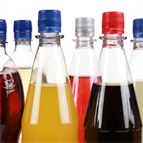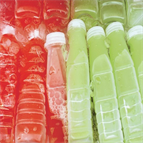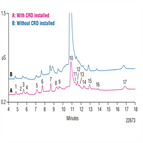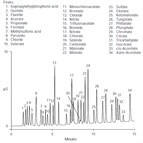Find methods for your needs
Refine by Feature
Displaying 1-5 of 10 results for Tag: Phthalate
AN336: Accelerated Solvent Extraction of Plasticizers from Polyvinyl Chloride Polymer
Instrument Type: Automated Sample PrepPolyvinyl chloride (PVC) polymers are typically composed of resins, stabilizers, pigments, and plasticizers. Plasticizers, 30–35% of the formulation, are used to soften the polymer, increase manufacturability, and provide form and function. Extraction and determination of plasticizers in PVC material are critical steps in evaluating a polymer for an intended use. This Application Note outlines the basic principles of using accelerated solvent extraction to extract plasticizers such as dioctyl adipate, trioctyl phosphate, dioctyl phthalate, and trioctyl trimellitate from PVC.
High-Resolution Accurate-Mass (HRAM) Phthalate Screening using Direct Analysis in Real Time (DART) Ambient Ionization
Instrument Type: MSMSPhthalic acid diesters (PAEs), or phthalates, are widely used in industry as a plasticizer in products like toys, flooring, personal care products and food packages. Some PAEs are classified as hazardous, affecting mainly the reproductive system and possibly contributing to cancer. Though regulated, these phthalates might be present and used during production of goods. We demonstrate the possibility of using precursor ion selection and full scan MS2 spectrum, and utilize it as a fingerprint for the characterization of the different compounds/isomers with nominal m/z ratios 279 and 391.
Analysis of Plasticizer Contaminants in Beverages and Milk using an Automated System Based on Turbulent-flow Chromatography Coupled to LC-MS/MS
Instrument Type: LCMSMSPhthalates are known endocrine disruptors that have been used to deliberately adulterate beverages and sports drinks in Taiwan. Phthalates and other plasticizers are ubiquitous contaminants particularly in fatty foodstuffs. Contamination arises from numerous sources such as the environment and food packaging. Cross-contamination with phthalates can easily arise during trace analysis in the laboratory and there are significant advantages in minimizing sample handling through online automated analysis. A method using online Thermo Scientific TurboFlow chromatography is presented.
TN62: Reducing Carbonate Interference in Anion Determinations with the Carbonate Removal Device (CRD): Trace Anions
Instrument Type: ICCarbonate can interfere with accurate quantification of adjoining anions, such as sulfate. Here we show the efficient removal of the carbonate peak from a trace analysis water sample using the Dionex CRD 200 device. In this example, a large volume (1000 uL) of water spiked with < 4 ug/L concentration of 17 anions is directly analyzed.
AN107: Ions (Anions) in Physiological Fluids
Instrument Type: ICOne of the most important applications of IC in clinical chemistry is the analysis of physiological fluids such as urine, plasma, and serum both for inorganic and organic anions and cations. This application note outlines the analysis of physiological fluids using ion chromatography. Part one shows the anion method, the IonPac AS11 is coupled with the Anion Self-Regenerating Suppressor (ASRS) to dramatically reduce eluent conductivity, thus allowing the use of a rapidly increasing hydroxide gradient for the separation of an extensive group of monovalent through trivalent.





